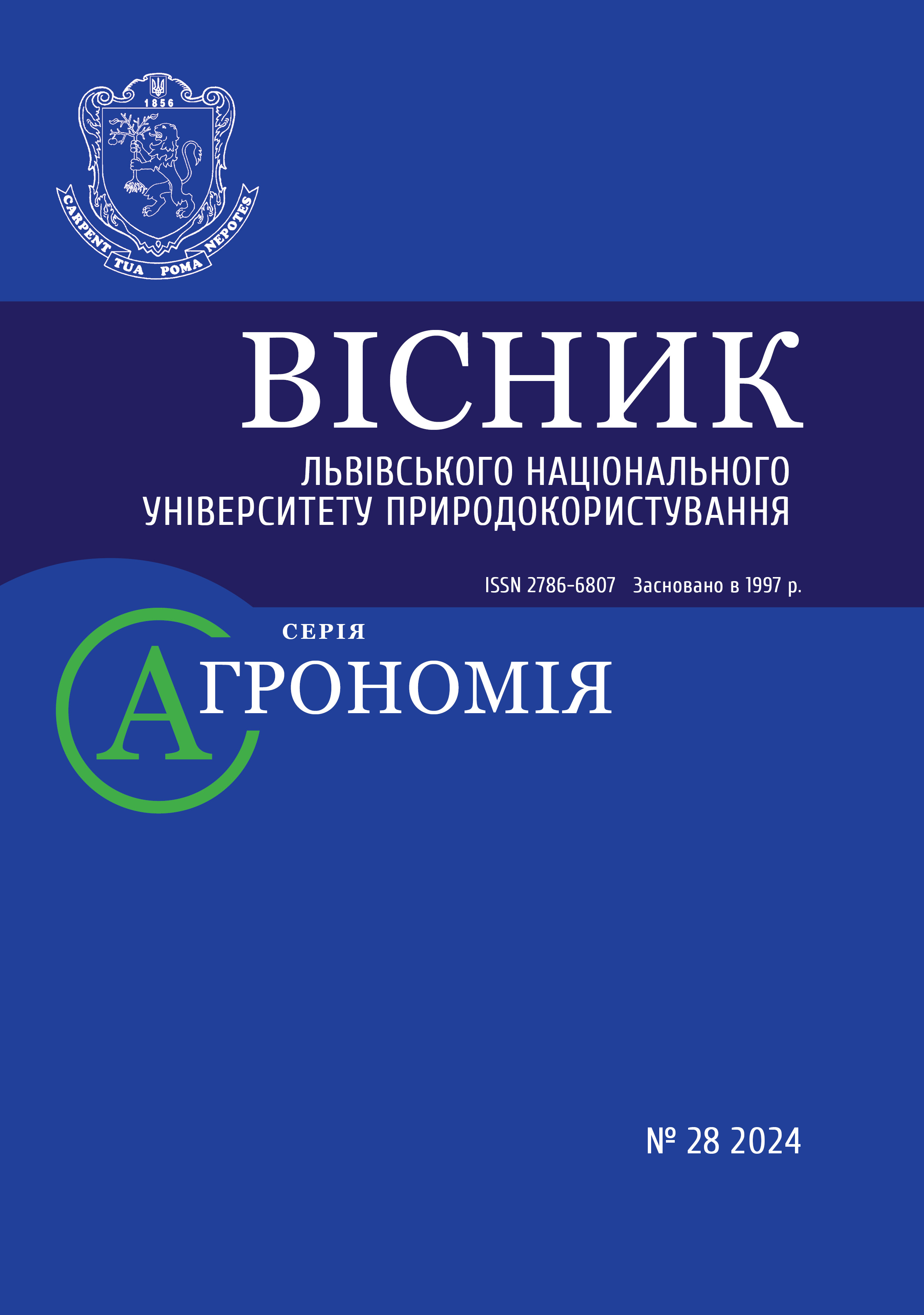THE YIELD OF AMARANTH DEPENDING ON THE SOWING METHOD IN THE CONDITIONS OF THE WESTERN FOREST-STEPPE
DOI:
https://doi.org/10.31734/agronomy2024.28.084Keywords:
amaranth, sowing method, crop structure, productivityAbstract
The study examined different methods of sowing Liera amaranth in the Western Forest-Steppe on dark gray podzolized soil. The research years had varying weather conditions compared to the long-term data. In 2020 and 2022, the average temperature during the growing season was 15.3 °C, which was 0.5 °C higher than the long-term data. In 2021, the average temperature was 14.8 °C, corresponding to the long-term average. In terms of precipitation, in 2020, there was 129 mm more than normal, in 2021 – 73 mm more than normal, and in 2022 – 28 mm more than normal. In 2023, there was a decrease in temperature in April and insufficient precipitation in May, with June and July precipitation exceeding the long-term average by 24.4 and 31.7 mm, respectively.
The seeds were sown at different row spacings: 15 cm, 30 cm, 45 cm, and 60 cm. The study found that different sowing methods with the same seeding rate resulted in different feeding areas for the plants. For instance, with a 15 cm row spacing, the feeding area was 15×25 cm, and there were 4 plants per 1 meter of row length with a distance of 25 cm between them. With a 30 cm row spacing, the feeding area was 30×14 cm with 7 plants per meter of row length at a distance of 14 cm between them.
With a row width of 45 cm, these indicators changed to 45×10 cm and 10 plants and 60×8 cm and 13 plants per meter of row length, respectively. The plant density before harvesting stayed within 22–24 units/m2 and was minimally impacted by the sowing method. Sowing with narrower rows resulted in more even plant placement, and the largest seed mass per plant (17.8 g) was obtained with a 45 cm row spacing. The yield of amaranth grains of the Liera variety was similar at row spacings of 15 cm, 30 cm, and 45 cm, ranging from 3.92–3.97 t/ha. The lowest yield over three years was seen with a 60 cm row spacing, at 3.70 t/ha due to unfavorable conditions created by the elongated rectangle nutrition area (60×8 cm) and dense plant placement. The results were almost the same for other nutrition areas and plant densities.
References
Amaranth: selection, genetics and growing prospects: a monograph / Hoptsiy T. I. etc. Kharkiv: HNAU 2018. 362 p.
Bekhatskyi Yu. S., Antoniv S. F., Rudnytskyi B. O. The efficiency of growing panicled amaranth for seeds depending on fertilization and the width of the rows. Problems of cultivation, processing and use of amaranth for fodder, food and other purposes: the first All-Ukrainian science and practice. conf. Vinnytsia, 1995. P. 34.
Casini P., Biancofiore G. Influence of row spacing on canopy and seed production in grain amaranth (Amaranthus cruentus L.) Agronomy Research. 2020. No 18 (1). P. 53–62. https://doi.org/10.15159/AR.20.015.
Duda O., Kapshtyk M. Key elements of amaranth cultivation. Offer. 2021. URL: https://propozitsiya.com/ua/klyuchovi-elementy-tehnologiyi-vyroshchuvannya-amarantu (Accessed March 03, 2024).
Dudka M. I. Agrotechnological foundations of increasing the productivity of annual forage crops in the Northern Steppe of Ukraine: [Unpublished. extended. thesis Dr. Agr. Sciences]. National Acad. Agrarian of Sciences of Ukraine, State Institute of grain cultures, 2020.
Dudka M. I. Cultivation of panicled amaranth (Amaranthus paniculatus) in the conditions of the northern steppe of Ukraine. Cereal crops. 2019. Vol. 3, No 1. P. 52–61. https://doi.org/10.31867/2523-4544/0060.
Dudka M. I. The influence of the method of sowing, the rate of sowing and the level of mineral nutrition on the productivity of paniculate amaranth. Horticulture and soil science. 2020. No 11 (1). P. 23–32.
Effect of levels of nitrogen and iron on yield of grain amaranth (Amaranthus hypochodriacus L.) under different planting techniques. Agricultural Science Digest, Patel K. I., Patel B. M., Patel S. J. Et al. 2012. No 32 (3). P. 193–198.
Hudkovska N., Hoptsii T. Yield of amaranth grain depending on the terms and methods of sowing in the conditions of the left-bank forest-steppe of Ukraine. Bulletin of Kharkiv National Agrarian University. Series “Plant growing, breeding and seed production, fruit and vegetable growing and storage”. 2018. Issue 2. P. 112-124.
Husiev M. H., Voitashenko D. P. Productivity of grain amaranth depending on the method of sowing and the rate of sowing. Irrigated agriculture. 2006. No 46. P. 109–112.
Kohut S. H. Optimizing measures of the amaranth sowing complex in the conditions of the southern Steppe: Unpublished. extended thesis Dr. Agr. Sciences. Kherson, 2006. 16 p.
Mishyn S. M., Kohut S. H., Kohut I. M. Mathematical interpretation of the dependence of amaranth seed yield on sowing density. Coll. of science Agrarian Bulletin of the Black Sea Coast. Odesa. 2011. No 57. P. 124–130.
Rotich A. N., Gweyi-Onyango J. P., Korir N. K. Diagonal offset arrangement and spacing architecture effect on growth and yield components of grain amaranth in Kenya. Asian Res. J. Of Agric. 2017. No 6 (1). P. 1–8. https://doi.org/10.9734/ARJA/2017/35312.
Rudyshyn V. K. Ways of sowing hairy amaranth. Problems of cultivation, processing and use of amaranth for fodder, food and other purposes: the first All-Ukrainian science and practice. conf. Vinnitsa. 1995, P. 48.
Shelest V. K., Pidpalyi I. F., Bernadskyi I. V. Seed sowing rate, row width and sensitivity to irrigation of amaranth panicle in the Central Forest Steppe. Problems of cultivation, processing and use of amaranth for fodder, food and other purposes; the first All-Ukrainian science and practice. conf. Vinnitsa, 1995. P. 40–41.
Tyrus M., Lykhochvor V. Yield of Amaranth (Amaranthus) depending on the cultivar in the conditions of Ukrainian Western Forest-Steppe. Scientific Horizons. 2021. No 24 (10). P. 43–51. https://doi.org/10.48077/scihor.24(10).2021.43-51.
Vasylieva Yu. V. Stankevych S. V. Prospects of amaranth cultivation in Ukraine and optimization of its chemical protection against harmful organisms. Agriculturist. No 4 (335). P. 22–23.


